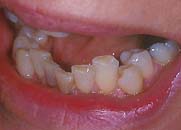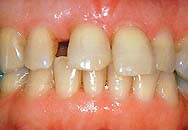Orthodontics for Adults
- Is it unusual for adults to have orthodontic treatment?
- Is adult orthodontic treatment successful?
- I’ve always had crooked teeth. Does in really matter?
- What are the most common orthodontic treatments for adults?
- What problems could make orthodontic treatment for adults more difficult?
- Can an orthodontist help my painful jaw muscles and joints?
1. Is it unusual for adults to have orthodontic treatment?
- More and more adults are having orthodontic treatment to correct crooked or crowded teeth.
- Orthodontics can make the teeth more attractive and more functional, by improving jaw alignment, and correcting “the bite“.
- Improved techniques have been devised for treating adults.
- Modern orthodontic braces are less obtrusive and adults are more willing to wear them.
Return to Questions
2. Is adult orthodontic treatment successful?
- Adult orthodontics is particularly successful for correcting crowding and jaw problems.
- Healthy teeth can be moved with braces at any age.
- Very similar treatments and appliances are used for children and adults.

Before |
|

After |
Return to Questions
3. I’ve always had crooked teeth. Does it really matter?
- It does. Crooked teeth can prevent you from chewing properly, and lead to jaw joint problems.
- Improving “the bite” can make eating more efficient and comfortable.
- Crooked teeth affect your appearance and most people want to look their best at any age.
- People with unattractive teeth are often too embarrassed to smile. Orthodontic treatment enables you to smile with confidence.
- Looking better can make you feel better about yourself, and can increase your self-confidence.
Return to Questions
4. What are the most common orthodontic treatments for adults?
- Correcting crowding or crooked teeth.

Crowding |
- Closing newly developed or old spaces between teeth.
- Correcting the position and alignment of teeth
Teeth often tilt into gaps left by extractions. These teeth have to be moved into a more upright position.
This correction makes it possible to use replacement crowns, implants, fixed bridges, or removable partial dentures to replace the missing teeth.
- The photographs below explain what can be done for an adult, when the orthodontist, periodontist and prosthodontist all work together.

Before |
|

Upper crowns
Lower brace |
|

Lower teeth
straightened |

Final result |
Return to Questions
5. What problems could make orthodontic treatment for adults more difficult?
- Periodontal Disease
- Adults may suffer from periodontal disease, which is a deterioration of the gums and underlying bone.
- Periodontal treatment will be necessary before the orthodontic treatment can start.
- Tooth decay
- All dental decay should be treated before orthodontic treatment starts.
- It is less comfortable to have dental treatment after braces have been fitted.
- Abnormal jaw relationships
- The growth of the jaws has been completed in adults, and so this treatment is not always possible.
- In children, the ongoing growth of the jaw can be directed to correct the abnormalities that are present.

Lower jaw
protrusion |
|

Lower jaw
protrusion |
- Worn down or broken teeth
- These must be built up or restored before orthodontic treatment can start.
- Lack of commitment
- Adult patients may find it hard to commit to long term treatment, especially to wearing braces for long periods.
Return to Questions
6. Can an orthodontist help my painful jaw muscles and joints?
- Your orthodontist or dentist will be able to diagnose the problem.
- This problem can be caused by the grinding and clenching of teeth.
- The action is unconscious and involuntary.
- The technical name for it is “bruxism.”
- Bruxism usually happens during sleep.
- It wears down the teeth, and causes stress and trauma to the jaw muscles and the teeth.
- The orthodontist will probably suggest a splint, bite plate or a nightguard to protect the teeth during sleep. This will also relax the muscles of the jaw.
- These devices should relieve and prevent the results of tooth grinding.
- The cause of the bruxism may be psychological, and may have to be treated by a suitable therapist.
See Bruxism

Nightguard |
|

Nightguard in place |
See Orthodontics for Children and Adolescents
Return to Questions
Copyright © 2012 of Simplyteeth – All rights reserved.
The material contained in Simplyteeth.com is offered as information only, see our full legal disclaimer.
This website has been invisibly watermarked to protect the copyright.
Site Map













